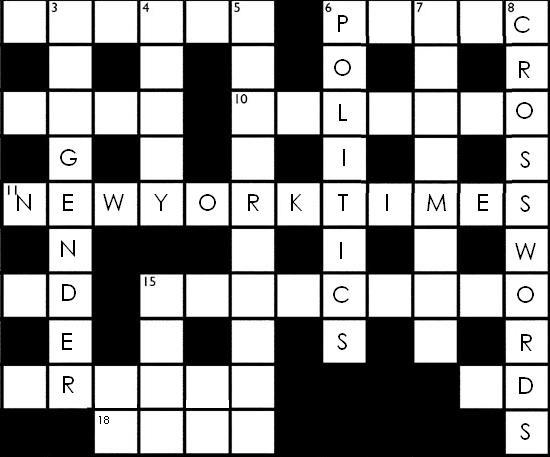
Often, a gender politics issue manifests in an obvious way: a new law that hinders women's rights. An offensive tweet. A tone-deaf comment on a cable-TV network.
But many other times, these issues manifest in far more subtle ways—as subtle, even, as a seemingly mundane New York Times crossword puzzle clue.
Just over a month ago, Elizabeth Gorski, one of the premier crossword puzzle constructors for the Times and other prominent outlets—and one of only a handful of star female constructors in the whole biz—had a puzzle published in the Wednesday Times. In it was this clue, positioned at 54 down: "What a big mouth might have." Answer? DELTA.
It was a perfectly clever clue/answer. Except in Gorski's original puzzle, 54 down was another clue and answer entirely. The prompt? "Intimate Affairs actress." The answer? Julie DELPY, the award-winning director, actress and singer-songwriter.
Editor Will Shortz, in his public notes about the puzzle, said he found the Delpy entry to be "unappealing"—with no other explanation given—and so excised it. Yet plenty of seemingly equally known male figures were left in, including BRUCE LEE, WALDO PEPPER, LINUS and BERNINI. Given the presence of those individuals, Gorski says, "I welcomed the opportunity to include Delpy—a strong, accomplished, contemporary woman."
The curious decision to rid the puzzle of such a notable female figure created a relative uproar in the usually calm crossword community. On her "Diary of a Crossword Fiend" blog, Amy Reynaldo remarked:
"I checked out Will Shortz’s notes on this puzzle at Wordplay, and I’m dumbfounded. One of the entries he wanted edited out of the grid because it was 'unappealing' was DELPY?? Julie Delpy, star of the acclaimed 18-year Richard Linklater trilogy with Ethan Hawke? Before Sunrise in 1995, Before Sunset in 2004, and Before Midnight in 2013 were all great films (still need to see the third one!) and I would have loved seeing DELPY in the puzzle. Hacking the name out of the grid seems . . . uncouth."
Rex Parker, known for his own popular blog about the Times puzzle, tweeted:
Julie DELPY is welcome in my #crossword any day of the week.
— Rex Parker (@rexparker) October 2, 2014
Gorski herself says she was surprised and disappointed such an esteemed artist—a woman spotlighted by the Times itself just a year ago—would be considered too "unappealing" for the nation's most pedigreed puzzle. "Julie Delpy is an actress, screenwriter and songwriter with two Oscar nominations. I think she’s enormously appealing," she notes.
Yet despite the backlash, Shortz told me he stands by his decision.
"Generally speaking, in crosswords, I prefer vocabulary that everyone knows to proper names that some people know and some don't. DELPY falls in the latter category. Personally, I didn't know the name, nor did my assistant (who, admittedly, is male). But even if we had, I probably would have changed the answer to DELTA anyway to broaden the puzzle's appeal."
Why would taking a prominent woman out of the puzzle broaden its appeal? This question, and others like it, lie at the heart of some deeper issues that have plagued the puzzle industry, including at the Times, since way before DELPY got the axe.
Crossword puzzling exists at a precarious intersection between games and publishing, two spheres that have long struggled with issues of gender parity. In terms of leadership structure, puzzles very much fit the male-centric mold, with control—at the construction and editing level—predominantly held by men. And in an industry enjoyed by so many—the Times puzzle subscriber base alone is 200,000—and endorsed by an institution as venerable as the Grey Lady, this is an issue worth investigating.
The DELPY incident is, if you will, a clue to something else. And it's not really that small at all.
Of Women And Puzzles
The very first Times puzzle editor was, in fact, a woman. From 1942 until 1969, Margaret Farrar oversaw the nascent puzzle section for The Times, cultivating new talent while developing many of the puzzling rules and formats that remain today. During her tenure, many puzzle constructors were women; in the '60s and into the '70s, it's been estimated that about half of the paper's puzzle creators were female—though Shortz, through his own assessment of a couple volumes of Farrar-edited puzzles, says the brakdown was more like 65% male, 35% female.
After Farrar's exit, the puzzle editing reins were handed over to a man, and it's men who have overseen the section since (Will C. Weng from 1969 to 1977, Eugene T. Maleska from 1977 to 1993, and Will Shortz starting in 1993). Coincidentally or not, the number of female constructors has since dwindled. It's been estimated that about 20% to 30% of puzzles are bylined by females today; last year, 31 men debuted a puzzle for The New York Times, compared to just six women who did the same.
As Parker puts it, "it's a boy-heavy world." But why? After all, there's nothing inherently gendered about clue-solving or trivia; nothing that would explicitly be keeping women from feeling comfortable entering the fray.
"No one knows the reason" for the gender gap, Shortz says. But he does have some theories. For instance, he says, it may have to do with a decline in the average age of constructors. He says that when he started in 1993, the average constructor age seemed to be around 55; now he estimates it's closer to 40. "In my experience, women tend to take up the hobby later in life. Guys tend to start when they're young. So with the decline in age of the contributors, there will be a greater percentage of guys."
This August, Patrick Merrell, a constructor himself who has had 81 puzzles published in The New York Times, conducted a survey of 104 crossword constructors, both men and women, which explored other theories that have been floated as potential reasons for the gender divide. Some, for instance, have relied on the age-old trope about women being tech-incompetent, since computers are a significant asset when creating puzzles. Yet the survey showed what Merrell calls a "statistical dead heat" between the genders when it came to computer assistance; for both men and women, approximately one-third learned construction using tech, one-third by hand, and one-third through a combination. For both groups, about 60% use computer assistance in construction, 8% construct by hand, and 32% use a combination.
Another theory Merrell tested was that "women were more affected by criticism," since several daily blogs that review the NYT puzzles can get surprisingly harsh. But Merrell says that "proved to be a small factor for both groups. If anything, men were a bit more sensitive to criticism than women."
As leaders in the industry struggle to understand the source of the gap, Reynaldo shares her own theory: a leadership system reliant on male power and perspective.
"I do believe that constructors bring their bodies of knowledge and their personal interests into the crosswords they make. Currently, many female constructors have to get their puzzles accepted by a male editor, first and foremost. One woman I know made a puzzle a few years ago whose theme was phrases with hidden Norse gods, and LOKI was hiding in HELLO KITTY. What a great answer, right? Unfortunately, the puzzle was rejected because the male editor didn't think HELLO KITTY (which just celebrated its 40th birthday recently, and which was quite familiar to me by the early '80s) was well-known enough."
Such decisions reflect the cyclical nature of gendered power structures. With men as gatekeepers, it's harder for female constructors to break through, which in turn sanctions a male purview in the puzzle content. This is especially problematic for an industry that caters to both men and women solvers. Says Reynaldo:
"It would probably help to have more women in gatekeeper roles as crossword editors. Currently, the newspaper puzzle editors are all men, and their experiences and interests aren't necessarily the same as women's. And yet a great many solvers are women—half, or more than half? I suspect it's more than half. Solvers would be better served by having puzzles that reflected their world. I'm not saying 'more knitting terminology, less about tools'—but puzzles constructed and edited by men likely present a decidedly male angle."
Shortz, for his part, doesn't see a clear connection between editorial oversight and the gender of those who's puzzles are published. He notes that though crossword magazines "are overwhelmingly edited by women . . . just like newspapers, they also publish far more puzzles by men than women." He also doesn't see male-created puzzles as catering more to a male audience. "I'm not sure you can tell a male-constructed puzzle from a female-constructed one," he says. "They're pretty much the same. A good puzzle is a good puzzle. And I'd be surprised if female solvers preferred female-constructed puzzles over male-constructed ones to any significant degree."
This might, to an extent, be true. But it is undermined in part by the DELPY incident itself. That, after all, was a clue centered on a strong, interesting woman, in a puzzle by a woman—then removed by a man.
If we can assume that, at least in some cases, puzzles created and edited by men shut out the female perspective, another question surfaces: What can be done to create change?
A Way Forward
Much of the muckraking has happened on the fringes of puzzling. In the indie online/mobile world, Reynaldo says there are "a lot of avenues for ambitious constructors and editors to carve out other paths to move forward. Younger editors and entrepreneurs have demonstrated considerably more interest in deliberately seeking out female constructors and trying to enact the change they want to see in the industry."
It's also worth celebrating those women who have broken through the ranks at the highest levels. Shortz singles out a roster of women he likes to work with: Gorski, Paula Gamache, Lynn Lempel, Andrea Carla Michaels, Mary Lou Guizzo and Bernice Gordon, who started at the Times in 1952 and, last January, had a puzzle published just after her 100th birthday. (He also, like pretty much everyone in the industry, says he "reveres" first NYT puzzles editor Farrar.)
Still, it's hard to see much change happening at the establishment level anytime soon. Reynaldo calls the pace of change in the publishing world "glacial," and there are signs that in the highest ranks, there isn't a sense that anything needs to change. Shortz is candid about his feelings on the topic:
"As for what can be done to address the imbalance . . . this is where you and I may disagree. I don't think it matters. Men like to do some things more than women, and women like to do some things more than men. I say let's celebrate our differences and move on."
But if solvers are pretty much equally divided among the genders, and there was a time when female constructors served in a more equitable capacity to men, is it really true that men like to do puzzles more? Or is it, perhaps, that this is a false and damning presumption entrenched at the top?
No one would ever accuse Shortz, a highly regarded editor, of being outright sexist or misogynistic. Nor would they say that of any of his compatriots in the industry. But that's not always how these things work. When an industry, be it puzzles or video games or newspapers or finance, is dominated by men and thus blind to how women could be affected by decisions, significant biases—and disciminatory hurdles—can accumulate.
It means that on one Wednesday, a puzzle landed at the doorstep of male and female solvers without the accomplished Julie Delpy in it, her absence posing a much bigger and more intricate kind of puzzle than can possibly be sewn up in a five-letter answer: What would it have taken for her to have been included as a clue?






